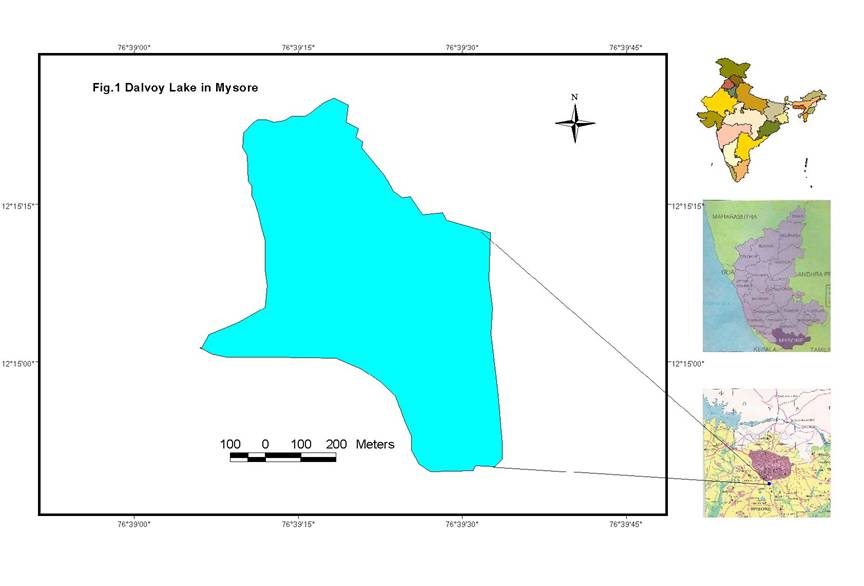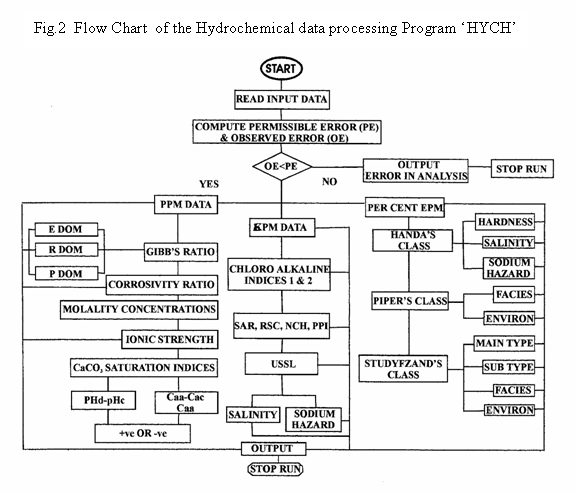HYDROCHEMICAL CHARACTERISTICS OF WATER IN DALVOY LAKE, MYSORE CITY.
Mahesha A. Balasubramanian |
Abstract :
The Dalvoy Lake in Mysore is fed by storm water as well as the drains from a major part of the city. The water that is entering into the lake through one of its major inlet drains is treated for solid waste. The lake water is primarily used for agricultural purposes towards the eastern side of the lake. In order to understand the water quality variations within the lake, samples were collected from the surface and also from depths ranging from 4 to 12 feet from the existing water level. These water samples were analysed for major cations, anions and also for some of the trace elements. The water analysis data was processed using a computer programme called HYCH. In this programme, numerical steps are adopted for the hydrochemical facies classification using the criteria of Handa, Piper, Stuyfzand and USSL schemes. According to Stuyfzand classification, these waters are of magnesium bicarbonate type. A major percentage of the water samples are coming under C3S1 type, when plotted in the USSL diagram for classification of irrigational waters, it indicates that the water is of moderate salinity and low sodium hazard and hence can be used for agriculture practices.
Key Words: Hydrochemistry, Lakes, USSL classification, Water Quality.
Introduction :
One of the most important crises of the 21st century is the availability of fresh drinking water, a resource that is basic to our survival and growth. Most of the freshwater bodies all over the world are getting polluted, thus decreasing the potability of water (Gupta et. al., 2005). Since the beginning of civilization, surface waterbodies have been the centres of cultural development and anthropogenic activity. The causes of pollution in these waterbodies are directly related to human activities. India, being essentially a rural and agrarian country, needs assured supply of water for a large rural population and even a larger agricultural area demanding assured input of water (Mukherjee et. al., 1993). In recent years, many of the lakes are being lost in the process of various developmental activities including unplanned urbanisation and expansion. Rest of the surviving lakes are reduced to cesspools due to direct discharge of industrial effluents, domestic sewage and unregulated dumping of solid wastes. Due to this, many lakes particularly urban lakes are disappearing so fast that it will bring far reaching consequences in the environment including changes in the micro climate of the areas. In this context, the present study has been undertaken to evaluate the hydrochemistry of a major lake near to the city of Mysore in Karnataka. This will help for the location-wise evaluation of the quality and its suitability for irrigation purposes. In recent years trace elements have received great attention because they provide a coded history of lakes' environment (Rippy et. al., 1982). This paper discusses the results of chemical analysis of water samples from Dalvoy lake, Mysore city with reference to their suitability for irrigational purposes.
Study Area :
Dalvoy Lake was constructed during the rule of Maharaja of Mysore. This lake is located 5 km south of Mysore city. This lake can be located in the toposheets No. 57 D/11/6 and 57 D/12/NE at 120 15' latitude and 760 39’ E longitude (Fig.1). The total catchment area of the lake is 2615.00 acres covering that is Dalvoy series, Shettykere, Marshy pickup, Sakamma pickup, and Gudumadanahally pickup. The main source of water to this lake is rainfall, Urban runoff from the elevated areas through storm water drains and sewage water from Mysore city and also the irrigation return flow from D.D. Urs (Varuna) canal distributories.

Material and Methods :
The sampling sites were selected by keeping in mind the locations of inflow and outflow. Water samples were collected from the surface and few metres below waterlevel to find out the varying characteristics, if any, of surface and bottom waters, by using specially designed airtight sampler, in clean and sterile polythene bottles. GPS receiver was used to record the exact location. Water temperature and dissolved oxygen were recorded on the site of sampling. The samples were preserved and further analyses including that for heavy metals were carried out. The trace element analysis was done using AAS. The computed result was processed with HYCH computer program (Balasubramanian, et. al., 1991). This program is capable of providing mostly needed output using the major ion chemistry data. It gives the interpretation of water quality based on water chemistry, facies, mechanisms of origin, type, suitability and usage factors like corrosivity and permeability. Fig. 2 shows the Flow chart of the Program.

Results and Discussion :
From the results of the analysis, it could be seen that the TDS in this lake ranges between 773 and 837(Map.3). The major ions are calcium and magnesium 98mg/L and 75mg/L, which are significantly present higher than the permissible limits against ISI standards of 75 and 30mg/L respectively (Map.1). Electrical Conductivity shown in Map.2. It has been seen that Chloride amounts to 179 mg/L (250mg/L) in this surface water, which is due to anthropogenic activities. This includes contamination from sewage and various types of industrial wastes, sodium 129mg/L (200mg/L) and nitrate 28mg/L (45mg/L), sulphate 27mg/L (200mg/L), are all observed within the permissible limit as per ISI standard. Hardness of the waters with reference to Handa's classification shows that the lake waters are characterised by both permanent and temporary hardness. The salinity and sodium hazard levels indicate that the waters can be used for agriculture practices. The trace element analysis data shows that the amount of copper 0.192 ppm (0.05ppm), nickel 0.376 ppm (0.02ppm) and manganese 0.144 ppm (0.1ppm) are more when compared to other trace elements and ISI standard permissible limit. The increase of copper concentration may be due to the seepage of effluent from the paper industry and intensive agricultural activities. Municipal waste and sewage, corrosion of Cu containing pipelines or fittings are the principal anthropogenic sources of Cu in surface water.
This lake water is used for agriculture, fisheries and washing automobiles. Extensive growths of water hyacinths and other hydrophytes are noticed during summer, which are collected and used for some human utilities and processing.
Conclusion :
Water pollution is not only an aesthetic problem, but a serious economic and public health problem as well. Periodical monitoring of the water quality is thus required to assess the condition of surface water. This will be helpful in saving the lake from further degradation. The results obtained in this investigation provide the characteristics of water most of all parameters are within the permissible limits prescribed except calcium, magnesium, copper, nickel and manganese. The overall quality of waters in Dalvoy Lake seems to be suitable for agriculture. The levels of trace elements such as copper, nickel and manganese are to be taken care of as far as the total quality is concerned.
Acknowledgement :
The authors are indebted to their respective departments, University of Mysore, for the facilities provided to carryout this research work. Thanks are also due to Dr. M.S. Sethumadhav, for analysing the trace elements of the water samples.
References :
-
APHA . 1985. Standard methods for the examination of waste and wastewater. 16 th ed. American Public Health Association , Washington , D.C.
-
Balasubramanian, A., Subramanian, S., and Sastri , J.C.V., 1991b, HYCH - Basic computer program for hydrogeochemical studies, Proc. Vol. Nat. Sem. on water. Govt. of Kerala, Trivandrum .
-
I.S.I., 1964. Indian standard methods of sampling and test (Physical and Chemical) for water used in industry, pp. 122.
-
W.H.O., 1984. The quality of water for irrigation use. U.S. Dept. Agri. Bull . 962, Washington , D.C. , pp. 40.
-
Gupta, S.K., Dixit, S., and Tiwari , S., 2005. Assesment of Heavy Metals in Surface water of lower Lake , Bhopal , India . Poll. Res . 24(4): 805-808.
-
Rippey, B., Murphy, R.J., and Kyle, S.W ., 1982. Anthropogenically derived changes in the sedimentary flux of Mg, Cr, Ni, Cu, Zn, Hg, and P in Lough Neagh, Northern Ireland . Environ. Sbi. Technol . 16: 23-60.
-
Mukherjee, S., Gupta, K., and Tutul, R ., 1993. Rural Surface Water Management: A Case Study of Birbhum District, West Bengal , India . Jour. Appl. Hydrology . Vol. No. 1to 4, pp. 69-75.